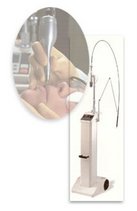Date: May 25, 1996
For Release: Immediately
Contact: Roseanne Hirsch, President & CEO, 206/806-2649
Luxar’s putting a new face on laser technology
Cosmetic Skin Resurfacing™ scanner gives laser surgery a facelift

Microsoft. Nintendo. Starbucks. Luxar. So did Luxar. The small company from Bothell, Washington, is marking its third year of profitability in the field of medical lasers. The technology Luxar’s founder co-invented and patented nine years ago is now widely used in cosmetic laser surgery. In the last few years, the popularity of laser skin resurfacing has grown to the point of being one of the most desired forms of aesthetic surgery. But since long before the skin resurfacing trend, Luxar’s carbon dioxide laser systems were leading their class of in-office surgical tools. With the launch of its NovaPulse™ laser system in 1995, the practice of Cosmetic Skin Resurfacing™ (laser dermabrasion) became both accessible and affordable to doctors everywhere. The NovaPulse laser comes with an assortment of accessories, including precision handpieces that work quickly and well in the treatment of damaged tissue of the perioral (mouth) and periorbital (eye) areas of the face. Luxar today released the NovaScan™, a laser scanner designed for full-face CSR™. The NovaScan received FDA clearance for laser dermabrasion on April 26, 1996, less than a year after its conception. Luxar engineers developed the NovaScan as a NovaPulse add-on designed to meet the full-face CSR needs of aesthetic medicine. Satisfying doctors, as well as their patients, meant combining fast coverage with fine control of ablation depth (removal of skin cells) in one tool. The NovaScan meets the challenge, performing full-face CSR in 24 minutes per patient. Luxar was incorporated late in 1987 by Dr. Katherine Laakmann, co-inventor of the sealed-off, RF-excited CO2 waveguide laser. In the first year, Laakmann furnished Luxar’s ground floor with her A-team: engineers who could conceive, develop and deliver ingenious laser technology. Mike Levy signed on as director of research and development. Steve Wojcik, a mechanical engineer and designer, and Paul Diaz, an electronics engineer specializing in software development, were hired to develop the company’s own in-office laser system. The team struggled to make ends meet while it developed products—and a cash flow. Team members shared housing to save costs, sometimes lending the company money or going without pay to buy time. Using its incredible wealth of knowledge of CO2 laser components, the team built on Luxar’s foundation by designing and developing products for hospital laser companies. Luxar’s first product was the Endoguide, a rigid endoscopic fiber and handpiece designed to work with surgical CO2 lasers with articulated arms. The Endoguide was launched in early 1989 for Surgilase. Working with money they were earning, Laakman, Levy, Diaz and Wojcik spent the next year in development of Luxar’s own CO2 medical laser. To help make ends meet, Wojcik contracted with Laser Industries, the parent company of Sharplan, to develop a high-powered, 150-watt CO2 laser. The sacrifices started to pay off when the LX-20 went into production in 1990. The 20-watt CO2 laser was a hit with doctors because of its flexible waveguide. Other laser systems used rigid, articulated arms and a series of mirrors to deliver laser energy to the tip. Luxar’s flexible fiber waveguide allowed a speed and control of hand and arm movements previously unknown to laser surgeons. In 1995, Luxar launched its most popular product yet: the NovaPulse™, a CO2 laser that offers two different wave types of laser energy on demand, allowing doctors to opt for a laser instead of a scalpel in more and more surgical and cosmetic procedures. Because of its record as the premier CO2 laser technology innovator, Luxar Corporation remains the leading supplier of CO2 lasers in the world. Of the original A-team, three are still with Luxar. Wojcik is manager of research and development; Diaz is the executive director of engineering; and Levy is chief scientist for the company. The company has thrived under the guidance of Roseanne Hirsch, the CEO who signed on a year ago. Company revenues are expected to reach $27 million in 1996. And with the January 1996 hire of the company’s marketing director, Ken Craig, a more prominent corporate profile will be seen. Current projects in R&D at Luxar include expanding the applications of the NovaPulse laser, and continued innovation in aesthetic medicine. ###
The first three names are familiar everywhere, known far and wide as successful, innovative companies who blazed trails for their unique products and technologies. All three started out small, and struggled. All three started in the Seattle area. The Luxar story
Luxar today
